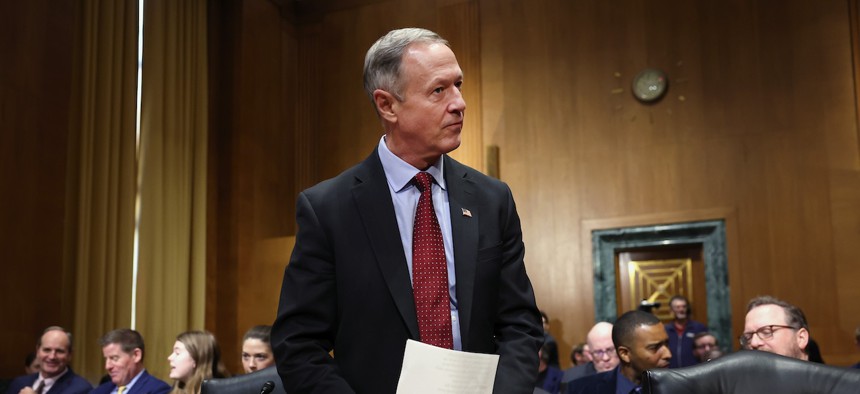
Social Security Commissioner Martin O’Malley said that in the three months since he was confirmed to his post, he has implemented a number of changes aimed at improving customer service and agency operations. Kevin Dietsch/Getty Images
O’Malley urges lawmakers to support hiring money for Social Security
President Biden’s fiscal 2025 budget proposal would boost the beleaguered agency’s funding by 9% over fiscal 2023 levels, which the new commissioner said is key to improving customer service.
Social Security Commissioner Martin O’Malley on Thursday told House lawmakers that his agency desperately needs additional funding as outlined in President Biden’s fiscal 2025 budget proposal to hire staff and improve customer service.
Over the last decade, Social Security’s administrative budget and staffing have stagnated, all while the number of beneficiaries the agency must serve has grown steadily. The agency headcount is at a 27-year low, and due to repeated continuing resolutions, again in the midst of a hiring freeze.
Though the Social Security Administration is directly funded by Americans’ payroll taxes, Congress each year must prove how much of that money goes toward administrative costs. Biden’s fiscal 2025 fiscal roadmap proposes a 9% increase to the agency’s budget compared with fiscal 2023 funding, for a total of $15.4 billion. Unlike many federal agencies, the Social Security commissioner is responsible for submitting their own budget request to the president and to Congress—under that plan, the agency’s funding would balloon to $16.4 billion.
In testimony before a hearing of the House Ways and Means Committee Thursday, O’Malley said that while Social Security has always operated as by far the most efficient insurance-style organization in the nation when it comes to overhead costs, the agency’s fiscal stagnation has been a significant contributor to its customer service crisis, as the agency has weathered scandals surrounding long wait times for service and improper payments. He noted that Thursday marked the first time in nine years that the agency has received a dedicated congressional hearing during budget season.
“Over the last nine years, we’ve seen a decline that amounts to an effective [budget] cut of 17% to 20%, depending on how you look at it,” he said. “By way of comparison, [here are] other insurance companies’ administrative overhead rates: Allstate operates on 19% of annual benefits payments, Liberty [Mutual] operates on 24% of its annual benefits payments, and Social Security—at least before 2018—operated on 1.2%. We’re down now to less than 1%. What’s the result of that? Today, customers wait on average 39 minutes when they call the 800 number. That’s an average, so sometimes it can be north of an hour.”
O’Malley said that in the three months since he was confirmed to his post, he has implemented a number of changes aimed at improving customer service and agency operations. Similar to his CityStat and StateStat data analytics initiatives that he pioneered as mayor of Baltimore and governor of Maryland, he convenes a series of biweekly meetings with agency leaders on a variety of service delivery issues, called SecurityStat.
“We have recruited a new team at the top of Social Security, as well as a cross-cutting performance management program called SecurityStat, where for one blessed hour every two weeks on a rotating basis, we lock the whirlwind outside the door and singularly focus on field operations,” he said. “[Finally], I want to thank the hardworking men and women of Social Security—or those who haven’t quit yet—for getting up every day and going to work, notwithstanding the overwhelming workloads and number of customers they have a duty to serve.”
But at the end of the day, what the agency really needs is an influx of new talent. Under Biden’s budget, $269 million would go toward the hiring and training of new field office employees; $79 million would pay for teleservice center hires; $85 million for processing centers, $89 million for hearing offices, and $2.8 billion to help rebuild the workforces of state disability offices, which are run by state governments but reimbursed by SSA. Another $1.7 billion would go toward IT modernization efforts.
“In my prepared remarks there’s a map that may look to you at first glance like a climate change map, because the only colors on it are yellow, orange and red,” O’Malley said. “Nothing is green. There is nowhere where we’re actually hitting in a timely fashion those disability determinations. In Montana, 85% of disability determination folks are trainees. It’s a tough job, and I guess some states have seen a 30% reduction in staffing compared to pre-pandemic levels.”
Rep. David Schweikart, R-Ariz., asked about the potential long-term impact of increasing the agency’s budget on the Social Security trust fund. But O’Malley said that the effect of the increases would be minimal.
“We need to get back to operating on 1.2% of annual benefit outlays—that’s how it was in 2018, 2017, 2016 and going back—but now we’re under 1%,” he said. “To those concerned about what it does to the trust fund, bringing funding back to the traditional 1.2% would only advance the [trust fund] depletion event by 30 days.”







